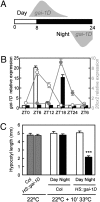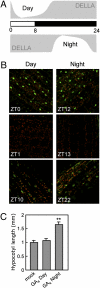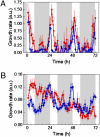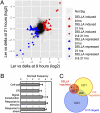Circadian oscillation of gibberellin signaling in Arabidopsis
- PMID: 21576475
- PMCID: PMC3107313
- DOI: 10.1073/pnas.1101050108
Circadian oscillation of gibberellin signaling in Arabidopsis
Abstract
Circadian clocks are endogenous timekeeping mechanisms that allow organisms to anticipate rhythmic, daily environmental changes. Temporal coordination of transcription results in a set of gene expression patterns with peak levels occurring at precise times of the day. An intriguing question is how a single clock can generate different oscillatory rhythms, and it has been proposed that hormone signaling might act in plants as a relay mechanism to modulate the amplitude and the phase of output rhythms. Here we show that the circadian clock gates gibberellin (GA) signaling through transcriptional regulation of the GA receptors, resulting in higher stability of DELLA proteins during daytime and higher GA sensitivity at night. Oscillation of GA signaling appears to be particularly critical for rhythmic growth, given that constitutive expression of the GA receptor expands the daily growth period in seedlings, and complete loss of DELLA function causes continuous, arrhythmic hypocotyl growth. Moreover, transcriptomic analysis of a pentuple della KO mutant indicates that the GA pathway mediates the rhythmic expression of many clock-regulated genes related to biotic and abiotic stress responses and cell wall modification. Thus, gating of GA sensitivity by the circadian clock represents an additional layer of regulation that might provide extra robustness to the diurnal growth rhythm and constitute a regulatory module that coordinates the circadian clock with additional endogenous and environmental signals.
Conflict of interest statement
The authors declare no conflict of interest.
Figures





Similar articles
-
Gibberellin driven growth in elf3 mutants requires PIF4 and PIF5.Plant Signal Behav. 2015;10(3):e992707. doi: 10.4161/15592324.2014.992707. Plant Signal Behav. 2015. PMID: 25738547 Free PMC article.
-
Genomic analysis of circadian clock-, light-, and growth-correlated genes reveals PHYTOCHROME-INTERACTING FACTOR5 as a modulator of auxin signaling in Arabidopsis.Plant Physiol. 2011 May;156(1):357-72. doi: 10.1104/pp.111.172684. Epub 2011 Mar 23. Plant Physiol. 2011. PMID: 21430186 Free PMC article.
-
Integrating circadian and gibberellin signaling in Arabidopsis: possible links between the circadian clock and the AtGID1 transcription.Plant Signal Behav. 2011 Sep;6(9):1411-3. doi: 10.4161/psb.6.9.17209. Plant Signal Behav. 2011. PMID: 21852756 Free PMC article.
-
From a repressilator-based circadian clock mechanism to an external coincidence model responsible for photoperiod and temperature control of plant architecture in Arabodopsis thaliana.Biosci Biotechnol Biochem. 2013;77(1):10-6. doi: 10.1271/bbb.120765. Epub 2013 Jan 7. Biosci Biotechnol Biochem. 2013. PMID: 23291766 Review.
-
The Transcriptional Network in the Arabidopsis Circadian Clock System.Genes (Basel). 2020 Oct 29;11(11):1284. doi: 10.3390/genes11111284. Genes (Basel). 2020. PMID: 33138078 Free PMC article. Review.
Cited by
-
Chemical Perturbation of Chloroplast-Related Processes Affects Circadian Rhythms of Gene Expression in Arabidopsis: Salicylic Acid Application Can Entrain the Clock.Front Physiol. 2020 Jun 18;11:429. doi: 10.3389/fphys.2020.00429. eCollection 2020. Front Physiol. 2020. PMID: 32625102 Free PMC article.
-
The Plant Circadian Clock: From a Simple Timekeeper to a Complex Developmental Manager.Cold Spring Harb Perspect Biol. 2016 Dec 1;8(12):a027748. doi: 10.1101/cshperspect.a027748. Cold Spring Harb Perspect Biol. 2016. PMID: 27663772 Free PMC article. Review.
-
Functional Characterization of the Gibberellin (GA) Receptor ScGID1 in Sugarcane.Int J Mol Sci. 2024 Oct 4;25(19):10688. doi: 10.3390/ijms251910688. Int J Mol Sci. 2024. PMID: 39409017 Free PMC article.
-
GIGANTEA gates gibberellin signaling through stabilization of the DELLA proteins in Arabidopsis.Proc Natl Acad Sci U S A. 2019 Oct 22;116(43):21893-21899. doi: 10.1073/pnas.1913532116. Epub 2019 Oct 9. Proc Natl Acad Sci U S A. 2019. PMID: 31597737 Free PMC article.
-
Hypocotyl transcriptome reveals auxin regulation of growth-promoting genes through GA-dependent and -independent pathways.PLoS One. 2012;7(5):e36210. doi: 10.1371/journal.pone.0036210. Epub 2012 May 9. PLoS One. 2012. PMID: 22590525 Free PMC article.
References
-
- Nozue K, et al. Rhythmic growth explained by coincidence between internal and external cues. Nature. 2007;448:358–361. - PubMed
Publication types
MeSH terms
Substances
LinkOut - more resources
Full Text Sources
Other Literature Sources
Research Materials

